There is not much like splitting a freshly baked high-quality bread, putting butter on it, or dipping it in the oil and tasting its blended harmonious flavors. And these days, you can have all this delightful bread-eating process without going to France on vacation.
In recent years, interest in traditional, artisan bread making has dramatically increased. You can even cook delicious, unusual, professional-looking bread in the cozy kitchen of your own home.
In this summary, you will find illuminating information about high-quality pastry baking at home. It will tell you the principles you need to know for recipes, explain which equipment you will need to buy, and show you how the process behind making great bread works.
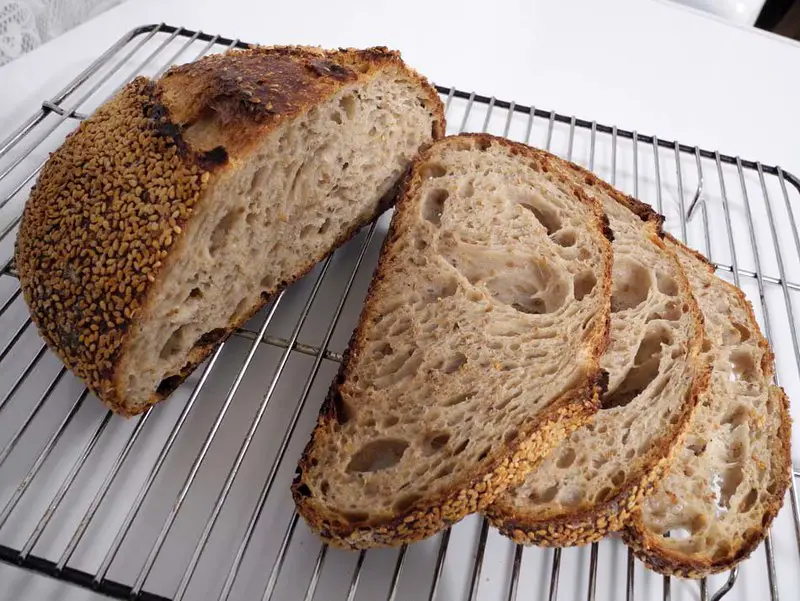
Chapter 1 – Turning into a baker
Almost everyone with an intense career has dreamed to quit their job and start a new life. Starting a new life as a baker sounds especially idyllic-baking bread like an artisan, serve your friendly neighborhood society, start working to comply with yeast culture at 3.30 every morning…
Wait, what?
Ken Forkish, the writer, does not appear as an average career changer. After working in the technology business for 20 years, he decided to set up a new life by taking bakery training and now runs Ken’s Artisan Bakery in Portland. However, his new work-life still requires a lot of discipline, although he has a new outfit instead of a suit and tie.
Bread baking can be very challenging, especially if you are a perfectionist person like Forkish. In a professional bakery, where all preparations must be completed urgently in the early morning, someone has to start working seriously early.
You will be relieved when you learn that it is possible to bake high-quality bread at home within a much more normal program. However, with a little care, you can go on to become a professional baker.
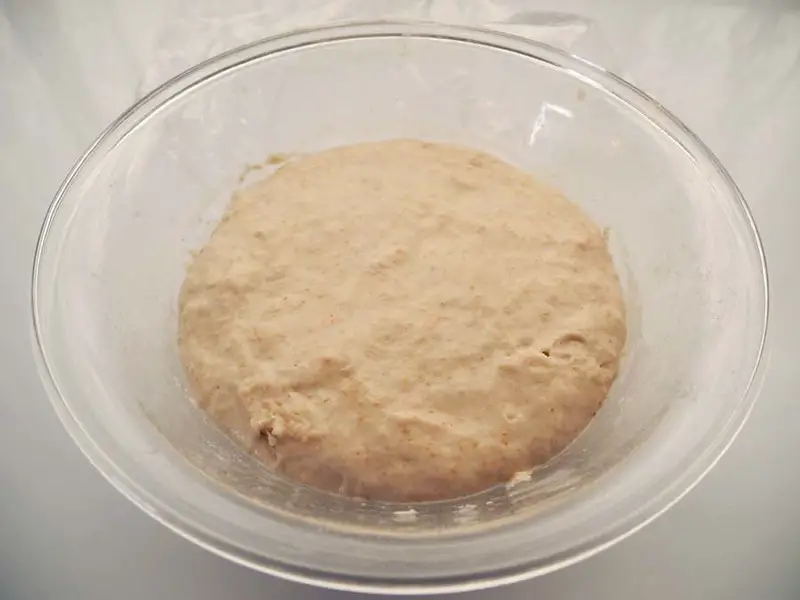
In 1995, Forkish was engaged in technology business and had never baked even a slice of bread in his life. But a magazine article he read pushed the limits of his imagination. The article was about a famous Parisian baker, Lionel Poilâne, who rejects modern technology and returns to the fine craft of traditional bread making.
As soon as he made his decision, Forkish became a member of the Bakers’ Association of America and enrolled in a bakery course at the San Francisco Baking Institute. He also worked with many experienced professional bakers to become like boulangeries, the largest and most traditional bakery in France.
He found his perfect location for his bakery in Portland, Oregon. This was a town with a great food scene that he thought would gladly accept his ambitious bakery plans.
He was right. Ken’s Artisan Bakery continues to increase its strength and recognition. Nowadays, bakery work has been improved. Forkish also founded a pizza business.
The reason for Forkish’s success is his obsessive attention to detail in what he does passionately. Fortunately, you don’t need to follow his compelling schedule to make perfect bread at home. However, you need to do much more than just apply a recipe exactly – you need to understand the recipe principles well. And now we will explain these principles.
Chapter 2 – Essentials
By looking at the title of Forkish’s book, you might think that only four basic ingredients are required to make bread. Technically yes, there are four ingredients, but in fact, there are two more other materials not included in your shopping list. These two materials are time and temperature.
Flour, water, salt, yeast, time, and temperature can come together in various possibilities to produce an infinite variety of bread. By experimenting, you can mix these ingredients to get the perfect baked bread with the desired variety in taste and texture.
Let’s begin with time and temperature. Anyone using the oven will understand that there is an inverse proportion between time and temperature: As the temperature rises, the time required decreases. This rate is valid for everything outside the oven. If you want a dough mixture to rise faster, put it in a warmer place in your kitchen. Or put it in the fridge to slow down the process a little.
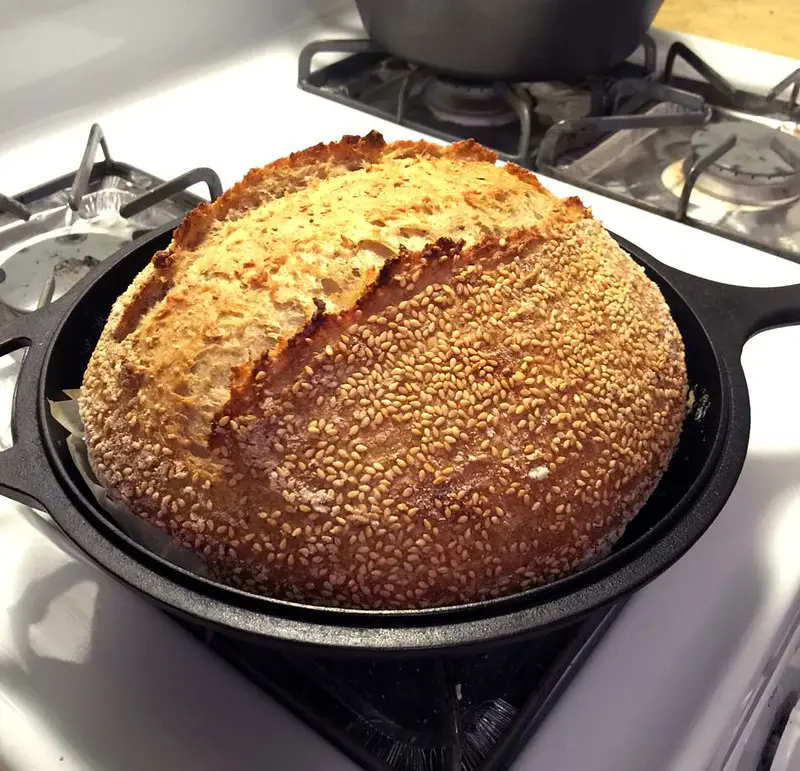
There are several different types of flour. In some recipes, white flour, flour made from the endosperm, which is only part of the wheat kernel, is used. But in other recipes, a mixture of white flour and whole wheat flour made from the whole kernel is used. You can also use other types of flour, such as rye and spelled.
How much water should you put in flour? Forkish wants his dough to remain relatively wet, which corresponds to adding about three quarters as much as water as flour. It is more difficult to make the soft dough into loaves; however, this type of dough produces more gas, resulting in a pleasant, light texture and a more complex flavor.
You should not hesitate to try different flour mixes as long as the total amount of flour you use remains constant. Since whole wheat flour is more absorbent than white flour- so you do not forget to add more water into the mixture.
And then it comes to yeast. Different ways to yeast provide different methods as you will understand later on. For now, save aside that you can also change the amount of yeast if you change other ingredients. For example, you can put less yeast in a mixture and then give it more time to grow. By doing this, you will get the same result with a richer flavor.
Chapter 3 – Tools
Ken’s Artisan Bakery is a proud business with an open kitchen of 1,200 square meters, an Italian oven weighing 15,000 pounds, a cool room known as a retardant where mixtures can be fermented at a certain temperature, and all the professional tools and equipment it needs. For cooking pizza, there is a wood-fired oven that reaches temperatures higher than 1000 ° F (538 ° C).
With equipment in the kitchen of your home, how can you compete with it?
Making bread is easier than you think if you have a few basic tools and equipment.
So, What is required for this? First of all, of course, an oven that I hopefully think you have. However, you may still need a special oven thermometer because many standard home ovens show incorrect temperature values.
Inside the oven, Forkish does not recommend using a baking tray or stone. A Dutch oven cannot be beaten at home. Its lid has the features that allow the bread to cook in its own steam and can rival the steam of a professional oven. Forkish recommends using a four-quart Dutch oven, although it’s also good at five quarters. To cook pizza, you should buy a pizza stone.
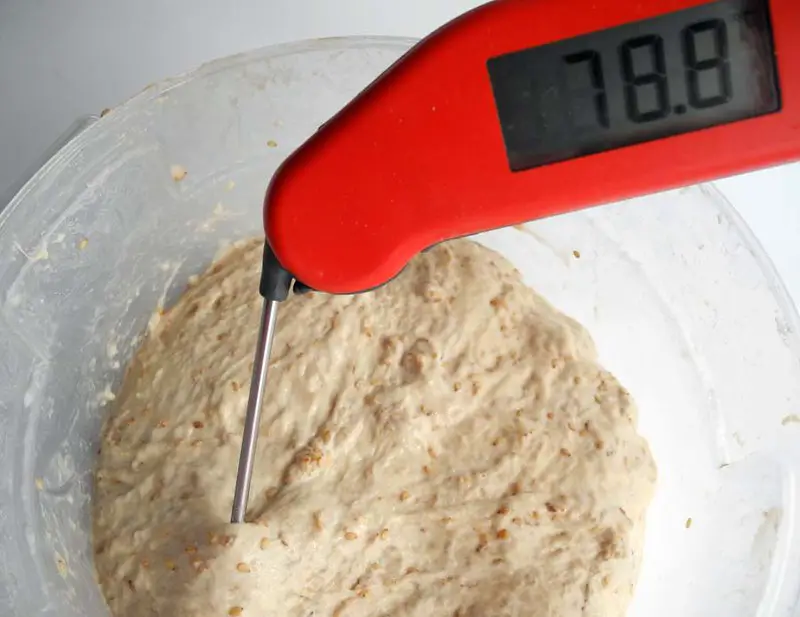
Also, a large round bowl is required, where you can mix your dough and then leave it to develop. Use some small bowls to make your levain culture or pre-fermentation – these terms will make sense to you in a minute. The fact that these bowls are transparent is very useful because you can watch your dough mixture grow without disturbing it. Also, use a proofing basket for the final rise of the dough before placing it in the oven. One of the top nine inches diameters will fit the four-quart Dutch oven perfectly.
By using digital kitchen scales, you can get much better results than measuring materials by volume. Because ingredients, especially flour, may have different densities: even if two different flour brands have the same volume, their weight may be different.
And also, do not forget to buy a probe thermometer. It is very important to add the right temperature water to the dough mixture.
You should buy a few oven mitts, especially if you want to cope with this warm Dutch oven. Beautiful clean tea towels are required to cover your proofing basket. Or you can use surprisingly effective plastic bags to cover the basket, which is also great for storing something in the refrigerator.
Chapter 4 – Bread starters and levain baking
Have you eagerly awaited to learn the famous trendy sourdough starter? Here we go… a little. It’s time to tell something about yeast.
First of all, know that using ready-made yeast is not wrong. It is the most important component of most of Forkish’s recipes. However, a fun part of making bread at home is that you can make your yeast culture yourself. And all you need for this fun is flour, water, and the most important element, time.
I’m sorry I couldn’t meet your expectations, but Forkish doesn’t actually use the term sourdough starter, or even just sourdough. He prefers to say the French term levain. But you should know that he knows everything about a yeast culture.
You may not notice this, but natural yeast is everywhere – in the air, in the soil, in the fruit, everywhere. Flour also has plenty of yeast, but you should try a little before you do anything.
The best feature of natural yeast has multiple types. Commercial yeast, unlike natural yeast, is a monoculture that gives a predictable flavor. The preparation and growth of a natural yeast culture will be much more distinct and complex.
However, using 100 percent natural yeast for a baked dough is for people who choose the route of natural nutrition and purification. More commonly, professional bakers like Forkish add their own levain cultures and a small amount of commercial yeast to the dough mixture on the day of bread baking. Using only a portion of this commercial yeast in the dough allows you to get a more fluffy and delicious bread.

The intermediary point between basic daily bread making and complex levain baking is to use pre-fermentation. This is to leave the dough mixture to ferment overnight. This dough mixture, which contains a small amount of commercial yeast, is left to develop slowly overnight to achieve a more complex flavor scale.
Forkish offers two types of pre-fermentation options. Poolish fermentation is a French term for a wet mixture typically obtained using equal amounts of flour and water. Biga is an Italian term and generally less water is used in this method. Both types have special uses: While Forkish uses the biga method for the ciabatta bread in his bakery, the poolish method, which produces softer dough, is generally used for baguette bread.
In this case, how do you get a poolish, biga, or levain culture for yourself at home? So we’re going to talk a little bit about the basic bread-making technique right now.
Chapter 5 – Preparing bread – the basic method (Part 1)
There are many ways to understand the bread-making process by changing flour, water, salt, yeast, time, and temperature ratios, and also by trying different flour mixtures, developing yeast in different ways.
But all methods have a common basis – not as detailed as a recipe, but a syllabus. And this blueprint is almost always the outline of the process you need to follow.
The basic method you should always apply when you make bread at home is as follows.
Step 1. Process.
Necessary things:
1kg of flour in the mixture you want- or 800g of flour for a levain bread; Approximately 750g or 600g of water at about 90 ° F or 32 ° C for a mixture of 75 percent flour. One kilo of flour is enough to make two loaves of bread. You can then divide the dough mixture in half. You can use the other piece to make a second loaf of bread or pizzas.
Use the amount of water as needed. You will need more water if you use whole wheat flour or less water if you use only white flour.
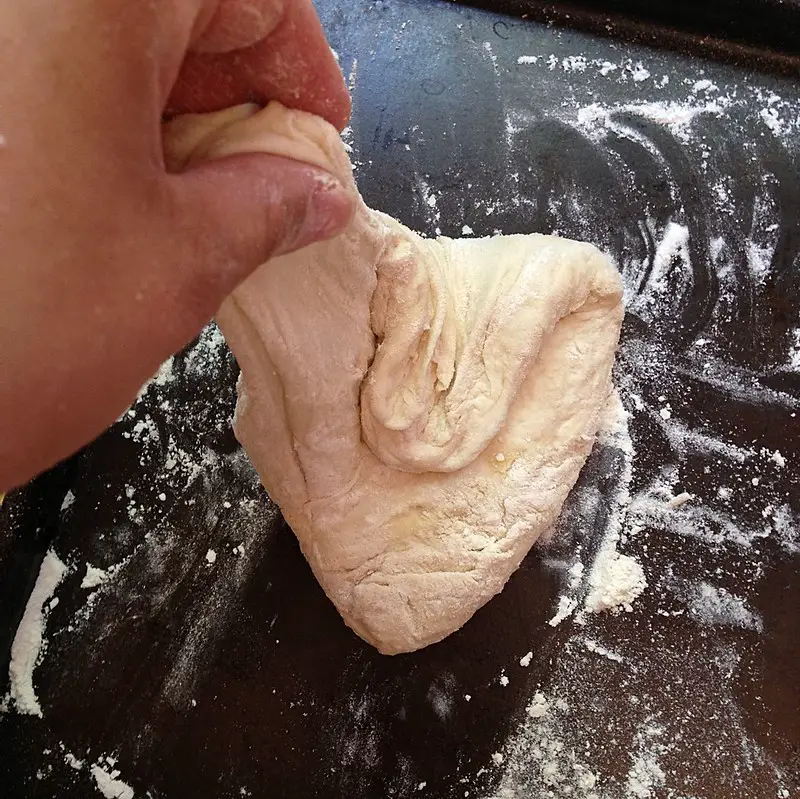
Put the flour and warm water together in a large basin.
Mix the dough using one hand. Then cover the mixture and leave it to rest for 20 to 30 minutes. This is the autolysis phase-rest of the dough mixture so that the flour absorbs the water properly.
If you are using a poolish or biga method that contains most of the recipe’s flour, do not leave your dough to rest the night before.
Step 2. Combining.
Ingredients to add:
20–22 g salt;
Dried yeast according to the method you will use;
If you are using, your fermentation or levain culture.
Add 3-4 g of yeast without pre-fermentation or levain if you are not going to ferment overnight-in this case you can use as little as 0.8g.
For a poolish or biga method, it is necessary to add 2-3 g of yeast at this stage, and at this stage, you can also add about 2g of yeast to a mixture of levain. If you prefer pure levain culture, do not add it at all.
If you prefer levain, add 360g culture, which should contain 200g flour, which will take you to a full kilo.
Soak your hand in a bowl of warm water, then put your hand in the dough mixture and slowly start mixing everything. After the ingredients are intermingled, continue mixing using a gripper technique -hold large pieces with your thumb and forefinger, continue to knead the dough until it hardens a little.
Cover the basin nicely again and let the dough rest and rise.
With this resting step, the dough mixture will ferment. You should usually wait for about five hours. Or if you put less yeast in the dough, you can wait for longer-in this case, let the mixture wait overnight.
However, as you will learn in the next step, you will have to cut the progression of the dough mix several times.
Chapter 6 – Preparing bread – the basic method (Part 2)
Step 3. Kneading.
Knead the dough several times with a little extra strength while the dough is resting. As you have done before, put your hand on the dough mixture and roll the bottom of the dough. Then turn the dough upside down, making it like a ball.
You should only do this twice or several times on softer dough. Try to make all the kneadings for the first few hours of dough’s rise.
Step 4. Letting it to proving.
Be patient until the dough rises. Then, sprinkle some flour on the counter and your hands, then slowly remove the dough from the basin. If you prepared dough with a kilo of the flour mixture, make sure to separate as little gluten as possible and divide it into two parts.
Roll each piece into a ball and place it in a well-floured proofing bowl. Cover it with a kitchen towel. Let it ferment a little more.
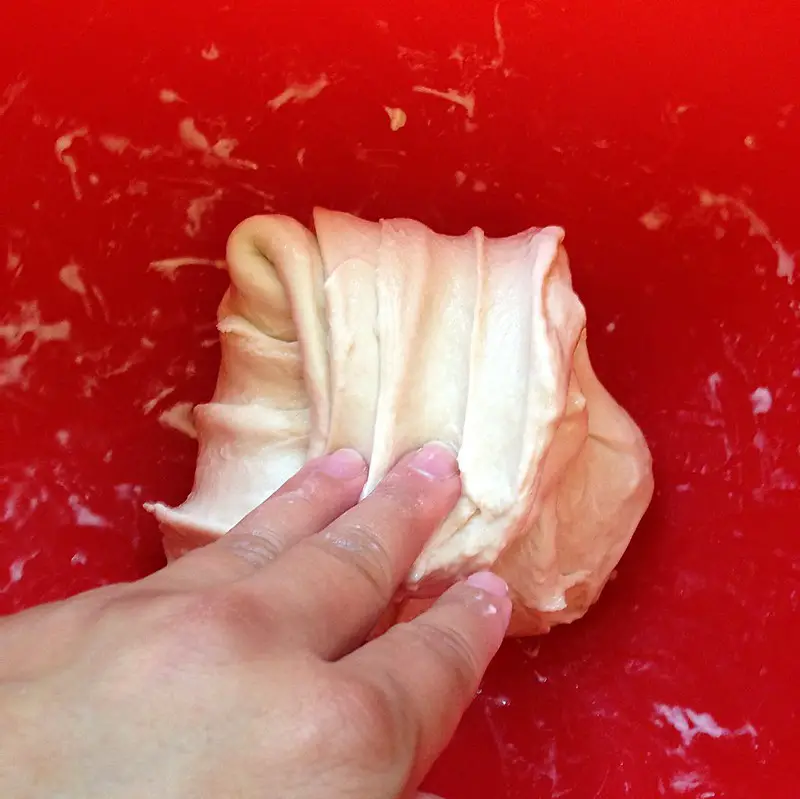
If you put instant yeast in the dough, typical fermentation time is about an hour or a little longer. Or you can leave the dough in the fridge overnight by extending the time and reducing the temperature. Pure levain mixtures take longer to ferment at room temperature – approximately four hours are required.
How do you know if the dough mixture is ready? Dip your finger into the dough. The dough should revert – but only slowly and not completely.
Step 5. Baking.
Before preparing the dough to its full consistency, preheat not only the oven but also the Dutch oven to 475 ° F or 245 ° C.
Once the oven has been heated sufficiently, open the Dutch oven – wearing gloves – and place it in the oven, without distorting the shape of the dough that has been fermented in a round shape.
Bake for 30 minutes, on the cover, then remove the cover and continue cooking as needed. This will take about 20 minutes or a little longer.
You should check the oven regularly so that the bread does not go beyond browning. Forkish prefers a dark shade of brown for the baked bread. This color is a slightly unburned version of bread.
Step 6. Relaxing.
Of course, you are not the one to relax! The bread. After taking the bread out of the oven, let it relax for at least 20 minutes before slicing. The bread will still be baked outside the oven.
Do not just put the bread on a flat surface – keep it on a rack or at least in the oven where you turn off the heat so that it is surrounded by air.
Chapter 7 – Creating a levain culture
You may think that it takes a lot of work to make a levain culture. Of course, we cannot hide that it requires attention and care for several days. However, once you become a habit, you will find that it is a beautiful and simple process that will require minimal effort every day.
You can also see it as an investment for big bread that is inherited in the future. Forkish’s levain culture has a history dating back to 1999.
How to make your own levain culture from the beginning is explained below.
Day 1
Mix flour and warm water with equal weights – let’s say both 500g – by hand in a small basin. Leave the mixture on for a few hours without covering it, then cover it and put it in a fairly warm place.
You can use any flour you want for the culture – Forkish’s own experience started with whole rye flour.
By doing this in the morning, you can evaluate the rest of the day in another way. Or, you know, go to work or whatever.
Day 2
The next morning, throw out three-quarters of the mixture.
Add the amount of flour and water you used yesterday to the rest of the mixture. Stir the dough and leave it on for a while before covering it once again.
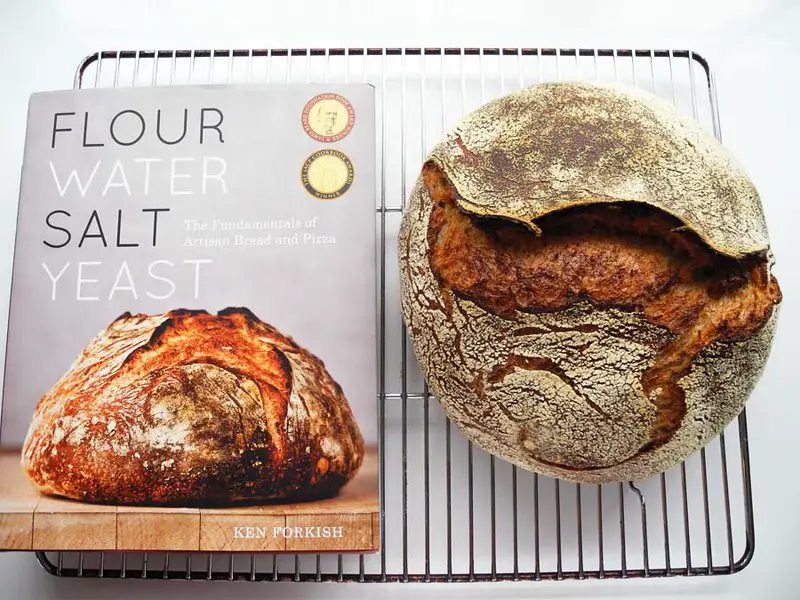
Day 3
The volume of the mixture should have increased twice, and the dough should begin to smell alcoholic.
Day 4
Just like yesterday, its volume must have increased again. This time, get rid of even more of the mixture until only a few hundred grams of the mixture are left behind.
Then add the same amount of flour and water to the remaining mixture as in the previous days, cover it and let it rest.
Day 5
In the morning, do the same as the previous day, but this time leave a little less mix behind. Then add as much flour as usual, but make sure there is a mixture of white and whole wheat flour in a ratio of 4:1. At a slightly lower temperature, use a little less water than the amount you always add.
Mix, cover, and rest.
The dough mixture will be ready for use in the afternoon. Bake!
Day 6, in an infinite loop
Now you have a mature levain culture and you can stop at this stage if you want. But you can keep doing this every day, you can take a little bit of dough to bake whenever you want.
Like on the 5th day, you can continue the process by adding the same amount of flour and water to the levain culture, which you discard most of it.
If you stop making bread for a while, you can keep your levain culture in the refrigerator for up to a month.
Chapter 8 – The different kind of bread
The bread baking has a scientific aspect, especially for those who are obsessed, like Forkish. But this is never just a game of numbers.
In other words, while you need to prepare it following the correct proportions of ingredients and the recipes mentioned above, baking also allows you to improve your creativity and find your unique way of making bread.
In this overview, you will learn how to determine the basic method and how to make your bread.
You can find a summary of the different types of bread you can try in the following section.
1. Single-mix process of making bread with cultured yeast.
This is a great type of dough preparation if you only have one day to make it. You can start preparing at 9.30 in the morning and get bread around 5 p.m.
You should wait for about five hours for this type of dough to rest and a little more than one hour for fermentation. Or by making a big change, you can add less yeast to the mixture and let it rise overnight in the refrigerator.
You can also change the amount of whole wheat flour you use up to 75 percent.
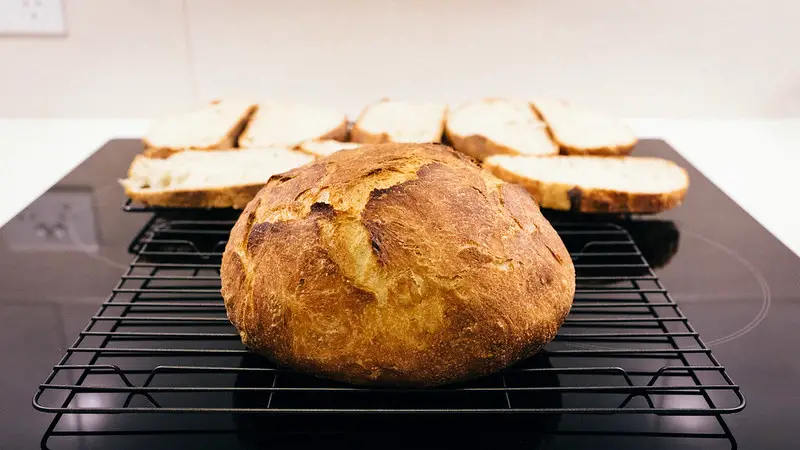
2. Bread starters.
It may take up to 14 hours to ferment a poolish or biga so that you can add it to the rest of the dough, so if you have some time the previous evening, it’s not hard to try.
These pre-ferment methods usually use at least half of the total flour. For the poolish of white-bread, the same amount of water and less amount of instant yeast is used. The next day, add salt, the rest of the flour, more water to this water and yeast mixture, and then give a few more hours of rest, and about an hour for fermentation.
If you start this poolish process early in the previous evening, you can take the bread out of the oven for lunch the next day.
3. Levains mixed with cultured yeast.
Forkish’s preferred method for this type of bread is to wait for the dough mixture to ferment overnight in the refrigerator, so you have to start working the day before it is planned.
After the morning supplement of the levain, it will be ready for use in the afternoon. Add the Levain mixture to your preferred flour, water, salt, and more yeast mixture and wait five hours for it to rise. That evening, separate the dough and put the raw bread in the mold – and put it in the refrigerator. You can bake your bread the next morning.
Forkish’s original attempts for this method include loaves of bread with caramelized walnuts and other bran-covered bread. Use your creativity!
4. Pure levains.
A pure levain mixture has a similar method, but since there is no commercial yeast in it, there is no need to keep the mixture in the refrigerator this time. You can rest the mixture to swell overnight, wait for about four hours to ferment the next day, and then your bread will be ready to bake.
Forkish bakes his special pain au bacon with this method by adding sauteed bacon to the mixture.
Chapter 9 – Preparing pizza and focaccia
You may have intended to use an entire kilo of flour, but you will get more dough mixture than two bread. But don’t worry- you can also use the dough to do other things.
And these things are not so ordinary- things as delicious as pizza and focaccia. Let’s learn the method for these delicious loaves of bread.
Of course, you can also prepare dough mixes, especially for pizza or focaccia.
How to prepare pizza
In general, you can also use the dough you prepared for making bread for pizza. And the method is applied in the same way. For a pizza, you need to divide about 350g of dough. Turn the dough you divide into a ball.
The dough ball you rolled should rest for up to an hour. Since it is easier to shape the cold dough in the form of a pizza roll, it is a good idea to cool the dough in the refrigerator after resting.

Shape the dough by tipping the dough on a well-floured surface and then using your fists to lengthen it-but only slowly. For a classic Italian style pizza, the dough should be quite thin. If you feel bold, you can improve pizza toss not only for the show, but also to produce equal delicacy all over the base.
Now it’s time to decorate on it. Use the best quality canned tomatoes possible- Forkish prefers San Marzano from Italy – and don’t compromise on quality mozzarella and basil. But of course, you can let your imagination come into play at this point.
As for the oven- let the temperature rise as much as possible. Of course, with caution, you can afford to try the broiler setting, especially to reach high temperatures. As a result, your pizza will be baked in less than ten minutes.
How to prepare focaccia
Focaccia may represent a broader meaning than perhaps a pizza. It is generally thicker than pizza dough and its sauces are more diverse, including tomatoes or cheese. Forkish makes focaccia in a cast-iron skillet or pan, both of which can be thicker than a pizza stone.
This method is also used for pizza, but of course, you will shape the dough for the skillet or pan instead of stretching it. The oven should not be as high as the temperature set for baking pizza.
Use your imagination for the materials you will put on it. Forkish has a wide range of materials, ranging from olive oil, salt, pepper, zucchini to caramelized onions, olives, and anchovies.
Flour Water Salt Yeast: The Fundamentals of Artisan Bread and Pizza by Ken Forkish Book Review
After ending her career in technology, Ken Forkish became a highly skilled professional baker thanks to her dedication and attention to detail. If you get the right tools and try to understand not only the features of the baking recipe but also the principles that support the process, it is possible to be perfect in baking bread even without a professional kitchen.
Equip your kitchen with the right tools and start baking.
The first thing you need to check is to make sure you’re using the right tools. Let’s not underestimate the Dutch oven. Baking bread in a Dutch oven is essential for producing quality bread like Forkish. Once you have all the right tools, you can start baking bread. But first, you need to properly understand the method of making bread.
